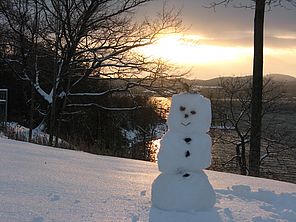Frosty Snow
December 2010

Frosty the snowman/ was a jolly happy soul
The first real snow fall of the season brings out the child in all of us. Snowmen pop up on lawns throughout the region. Snow in itself is a fascinating substance, worthy of attention.
The Stokes Guide to Winter describes seven common shapes of snow crystals. The types of crystals that occur in any given storm depend upon the temperature and the humidity of the air in which the crystals form. The typical snow flakes are six-pointed stellar crystals which form in low clouds at moderate temperatures and high humidity. Stellar crystals often interlock as they fall. The same conditions can also produce hexagonal plate crystals which drift, but do not interlock. The bulk of most snowstorms is actually comprised of needle crystals, slender pointed columns. These often freeze together and shatter when striking the ground. Colder, drier conditions produce very small columnar crystals; these make up wispy cirrus clouds but are uncommon in actual storms. When hexagonal plate crystals or stellar crystals become coated with ice they can form small pellets referred to as graupel, which bounce when they land. Finally, some crystals defy simple categorization and are referred to as asymmetrical crystals.
Stellar crystals and hexagonal plate crystals are the best for making snowmen, though needle crystals work as well. These crystal types most easily link together when compressed. In short, they make good packing snow.
So he said, "Let's run and/ We'll have some fun/ Now before I melt away."
Once snow lands, the crystals begin to lose their shapes. The fine arms of stellar crystals break. Molecules of water on the crystals shift between solid, liquid, and gaseous phases of water, and sometimes move from one crystal to another. Eventually all crystals become tiny ice particles. The change and decomposition of a snowpack or our snowman is referred to as metamorphosis.
There are three different types of metamorphosis as described by Peter Marchand in his book Life in the Cold: destructive, constructive, and melt metamorphoses. The different metamorphoses may occur simultaneously within a snow pack. Which type dominates varies over time and according to external weather conditions.
Destructive metamorphosis occurs when the temperature is approximately equal throughout a snowpack. Flakes deteriorate and become more rounded as water molecules reorder on the surface of the crystals. Wind and the weight of overlying snow can pack crystals together promoting destructive metamorphosis. Marchand notes, “Both the snowpack density and the mechanical strength of the snow increase substantially … often within just a few hours after snowfall.”
Constructive metamorphism occurs when water vapor migrates upward in the snowpack and re-condenses in colder regions. Typically, the bottom of a snowpack is warmest because it is closer to the earth which still retains some of the heat energy accumulated throughout the summer. The upper portion of the snowpack remains exposed to the cold winter air. In the warmer portion of the snowpack, water molecules evaporate from individual crystals and then migrate to where they are less abundant. As a result, crystals at the bottom of the snowpack become smaller while those toward the top of the snowpack become larger. In constructive metamorphosis, the snowpack loses strength.
Melt metamorphosis occurs when any portion of the snowpack is exposed to temperatures above freezing. When the air is above freezing, melt metamorphosis may occur at the top and bottom of the snowpack while a colder region persists in the middle. Melt water percolating down from the top may refreeze before reaching the ground. Freezing releases the heat that allowed the water molecules to move. In this way, energy is transferred from the surface throughout the snowpack. Melt metamorphosis also occurs when rain falls on or fog forms over snow. In the case of fog, “for every gram of water vapor condensed over the snow surface, enough heat energy is released to melt seven times as much ice”, notes Marchand.
You may notice the color of snow changes as you pack it to make your snowman. While fluffy new fallen snow often has a bluish hue, as it is packed, the color is lost. The act of packing snow increases its density. As snow becomes denser, more crystals are packed into a smaller volume. Each crystal added increases refraction, scattering, and absorption of light. Small increases in the density of fluffy snow are equivalent to large increases in snow depth. Destructive metamorphosis has the same effect on the overall snow pack.
But he waved goodbye saying,/ "Don't you cry,/ I'll be back again some day."
Approximately 20% of annual precipitation falls between the beginning of December and the end of February in our area, much of it as snow. However, increases in regional temperature may mean more falls as rain in years to come.
We have seen measurable increases in both temperature and precipitation in our region. Climate models confidently predict continued increases in temperature, but it is more difficult to generalize about impacts on precipitation, though most scenarios suggest an increase.
Though it would be prudent to assume an increase in temperature means a diminishment of snow, the increase in precipitation could actually have the opposite effect if temperatures increase but remain below freezing. It does however seem intuitive that in the future more of our winter precipitation events will come in the form of rain and what snow we have will melt earlier. Under a worst case scenario, our faith in Frosty’s promise to “be back again some day” could prove futile. Build your snowmen while you can.
Lake Look is a monthly natural history column produced by the Lake Champlain Committee (LCC). Formed in 1963, LCC is the only bi-state organization solely dedicated to protecting Lake Champlain’s health and accessibility. LCC uses science-based advocacy, education, and collaborative action to protect and restore water quality, safeguard natural habitats, foster stewardship, and ensure recreational access.
Get involved by joining LCC using our website secure form (at www.lakechamplaincommittee.org), or mail your contribution (Lake Champlain Committee, 208 Flynn Avenue - BLDG 3 - STUDIO 3-F, Burlington, VT 05401), or contact us at (802) 658-1414, or lcc@lakechamplaincommittee.org for more information.
